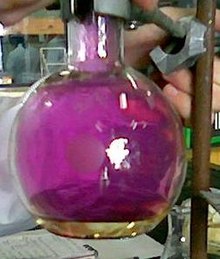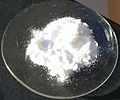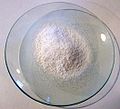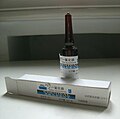Does Iodine Dissolve In Water

Iodine is a element. Its atomic number (which is the number of protons in it) is 53, and its atomic mass (the number of protons plus neutrons) is 127. It is part of the Group 7 (halogens) on the periodic table of elements and its electronic configuration is 2,8,eight,18,17.[1] Information technology is a nonmetal.
Properties [change | change source]
Physical properties [change | modify source]

Iodine is a night purple-black solid. Information technology is also a nonmetal and a halogen. Information technology sublimes when heated to make a bright imperial vapor. This vapor is very irritating, although colorful. Iodine does not deliquesce in h2o, but it does dissolve in a solution of an iodide in water. It dissolves easily in organic solvents.
Chemical properties [change | change source]
Iodine is at the bottom of the halogens and is the least reactive of the halogens. Iodine is an oxidizing agent, though non as strong as bromine or chlorine. It tin can become the colorless iodide ion if another atom or molecule gives an iodine atom one of its electrons. This is called reduction. Iodine reacts with hydrogen sulfide or hydrazine to make hydriodic acid. Iodine dissolves in oleum to make a bright blue solution of Itwo + and sulfur dioxide. This cation is as well made when iodine reacts with antimony pentafluoride.
Iodine reacts with bases to brand hypoiodite and iodide. The hypoiodite disproportionates to iodate and iodide. Iodine reacts with nitric acrid and chlorates to make iodates, also. Iodine reacts violently with some metals like aluminium to make big amounts of heat and toxic vapors.
Chemical compounds [modify | change source]
Iodine forms chemical compounds in several oxidation states: -1, +1, +iii, +5, and +seven. This is typical of the halogens except for fluorine. -1 compounds equally iodides are the virtually common. Most organic iodine compounds are in the -ane oxidation state. Almost iodides are colorless or cerise-yellow and are weak reducing agents. +1 and +3 compounds are quite rare. They are both oxidizing agents. +1 compounds are constitute equally iodine monochloride and hypoiodites. +three compounds are constitute as iodine trichloride or iodine trifluoride. +5 compounds are constitute as iodates and iodic acid. Iodine pentafluoride and iodine pentoxide are iodine compounds in the +5 state. +5 and +7 compounds are all stiff oxidizing agents. +seven compounds are unremarkably constitute equally periodates and periodic acid. Iodine heptafluoride is as well in the +7 oxidation land.
Potassium iodide is one of the most mutual iodides. Iodides are normally colorless but turn yellow after being in air because the iodide is oxidized to iodine. Iodides react with acidified manganese dioxide or chlorine to make iodine. Iodine monochloride is a crimson or brownish liquid. Iodine trichloride, equally well equally iodine trifluoride, are yellow solids. Iodates like potassium iodate are colorless solids similar to chlorates. Iodic acid is the merely stable oxidizing element of group vii acid. Chloric acrid, past comparison, is very unstable and unsafe. Iodine pentoxide is a white solid, and iodine pentafluoride is a xanthous liquid. Periodates, like sodium periodate, are colorless solids similar to perchlorates, although weaker oxidizing agents. They decompose to iodates when they are heated. Periodic acid is not as stable as iodic acid. Iodine heptafluoride is the only iodine(7) compound.
-

Copper(I) iodide
-

Sodium iodide
-
Silverish iodide
-
Potassium iodate
-
Iodine trichloride
-
Iodine monochloride
History [alter | alter source]
It was discovered past Barnard Courtois in 1811. He burned seaweed to get sodium carbonate and reacted the residuum with sulfuric acid. In one case, he poured too much sulfuric acid on the seaweed and purple vapor came out which made dark blueish-black crystals on a cold surface. He did not have enough money to meet whether it was a new element or not. He gave samples to several chemists, who identified it as an element in 1813.
Occurrence [change | alter source]
Iodine is too reactive to be in nature every bit an element. Iodine compounds are non mutual in the ground. There is a mineral called caliche that is institute in dry deserts. It has iodate in information technology. Iodide is found in seawater. Kelp has quite large amounts of iodine in it. Iodine is 1 of the heaviest elements needed past living things. If people do not get enough of it, they get a disease known as goitre. Most salt has iodine in it, in the class of iodide or iodate. People can also take iodine pills to brand sure they go enough.
Preparation [change | alter source]
Kelp was burned and the iodine extracted from the ashes in the 18th and 19th century, but now it is not good enough for common use. Most iodine now is extracted from seawater. Chlorine is reacted with seawater to change the iodide to iodine. Air is blown over the water to evaporate the iodine. And so the iodine is reduced with sulfur dioxide to hydriodic acid. Then the hydriodic acrid is oxidized with chlorine again to make iodine. This process is repeated until the iodine is pure.
A very pure form of iodine is fabricated by reacting copper sulfate and potassium iodide. This makes copper(Ii) iodide which is non stable. It breaks down into copper(I) iodide and iodine, which is pure.
Uses [change | change source]
Iodine is used every bit a catalyst for making acetic acrid. Beast feed also has iodine in it for nutrition. Iodine is used for a disinfectant. Tincture of iodine is a common iodine disinfectant. Iodine can be used to forestall thyroid cancer after a nuclear explosion. After a nuclear explosion, radioactive iodine fills the air. The radioactive iodine easily goes into the thyroid and causes cancer. When people accept iodine tablets, it fills upwardly the thyroid with non-radioactive iodine which prevents any radioactive iodine from coming in.
Iodine compounds tin can be used in X-rays because 10-rays cannot go through them easily. Some metals are purified using their iodides. Silverish iodide is used in photographic film and cloud seeding. Erythrosine is a food coloring that has iodine in it. Iodine can be used to make illegal drugs so it is restricted in some areas. Iodine can be used every bit a test for reducing agents. Iodine turns colorless when mixed with a reducing agent. Iodine also turns blackness when mixed with starch. Iodides get colored when mixed with oxidizing agents.
Safety [change | modify source]
Iodine can irritate skin. Its vapors are irritating to the lungs. It is less toxic than the other halogens, though. 2-iii grams of iodine can impale. Iodides are only toxic in big amounts.
References [alter | change source]
- ↑ "Iodine Element Facts". Chemicool. Retrieved 2011-03-16 .
| Periodic tabular array | |||||||||||||||||||||||||||||||||||||||||
|---|---|---|---|---|---|---|---|---|---|---|---|---|---|---|---|---|---|---|---|---|---|---|---|---|---|---|---|---|---|---|---|---|---|---|---|---|---|---|---|---|---|
| H | He | ||||||||||||||||||||||||||||||||||||||||
| Li | Be | B | C | N | O | F | Ne | ||||||||||||||||||||||||||||||||||
| Na | Mg | Al | Si | P | S | Cl | Ar | ||||||||||||||||||||||||||||||||||
| M | Ca | Sc | Ti | V | Cr | Mn | Iron | Co | Ni | Cu | Zn | Ga | Ge | As | Se | Br | Kr | ||||||||||||||||||||||||
| Rb | Sr | Y | Zr | Nb | Mo | Tc | Ru | Rh | Pd | Ag | Cd | In | Sn | Sb | Te | I | Xe | ||||||||||||||||||||||||
| Cs | Ba | La | Ce | Pr | Nd | Pm | Sm | Eu | Gd | Tb | Dy | Ho | Er | Tm | Yb | Lu | Hf | Ta | Westward | Re | Bone | Ir | Pt | Au | Hg | Tl | Pb | Bi | Po | At | Rn | ||||||||||
| Fr | Ra | Ac | Thursday | Pa | U | Np | Pu | Am | Cm | Bk | Cf | Es | Fm | Md | No | Lr | Rf | Db | Sg | Bh | Hs | Mt | Ds | Rg | Cn | Nh | Fl | Mc | Lv | Ts | Og | ||||||||||
| |||||||||||||||||||||||||||||||||||||||||
Does Iodine Dissolve In Water,
Source: https://simple.wikipedia.org/wiki/Iodine
Posted by: whitehavager.blogspot.com





0 Response to "Does Iodine Dissolve In Water"
Post a Comment